Two Tales in Education
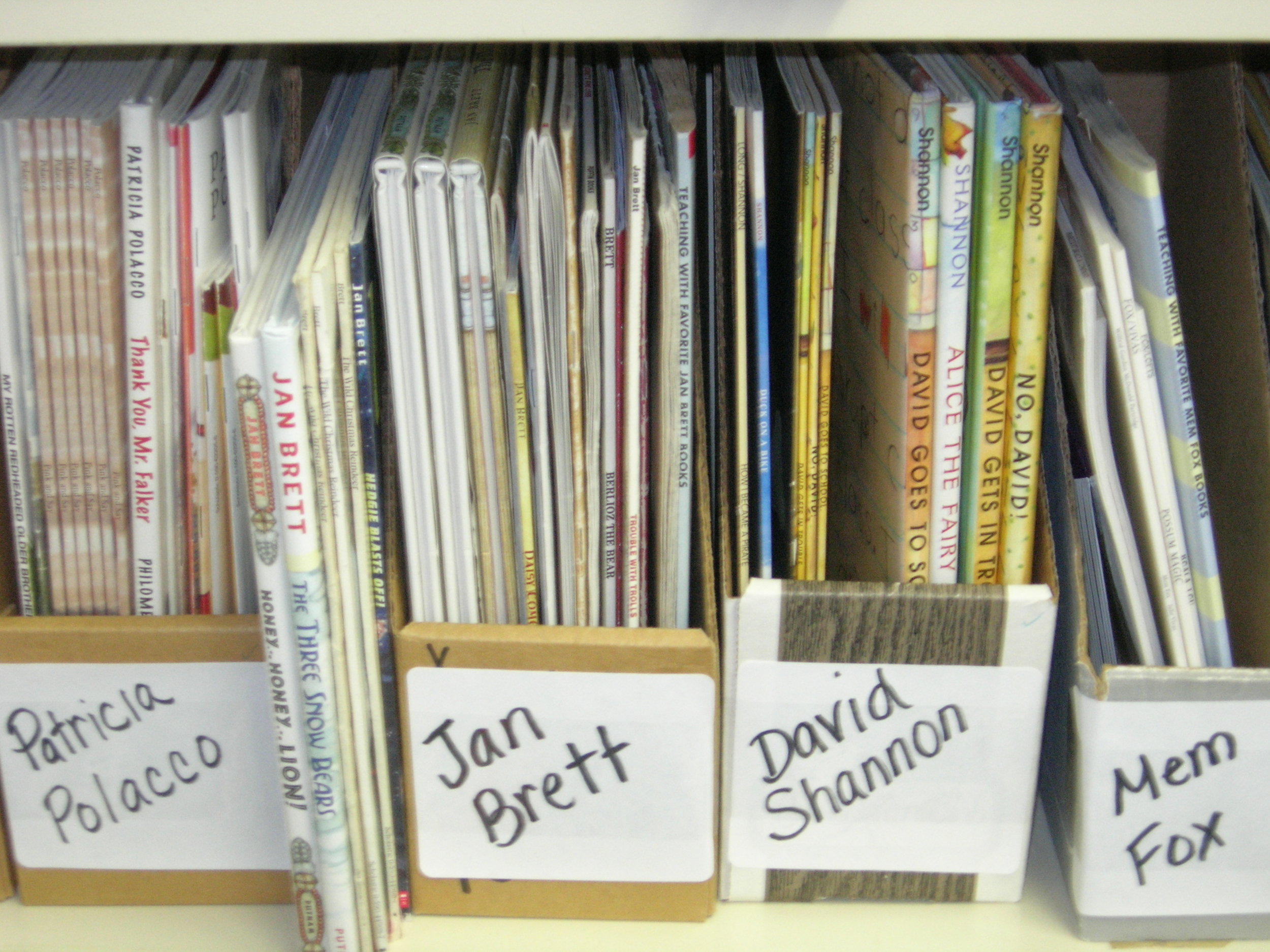 Two stories from the education world caught my attention this week, and I feel that both are worth the time to read. The first story, Why Teachers Quit by Liz Riggs, is a cautionary tale from 2013 about teachers and burn-out. The second, Silicon Valley Courts Brand-Name Teachers, Raising Ethics Issues is by Natasha Singer of the New York Times. It is a warning for anyone who worries about the possible effects of corporate America's influence in schools and school materials.The Atlantic recently reposted Liz Riggs' 2013 article Why Teachers Quit which was originally printed in October 2013. Even with a 4-year time gap, this is an article that is relevant and worth reading for anyone interested in retaining educators. The turn-over rate cited in the article, 40-50%, refers to the numbers of teachers leaving the education profession within the first five years of their career. While I believe this attrition rate to be lower in 2017 thanks to strong induction and mentoring programs available to beginning educators, many beginning teachers continue to leave education for other fields.Although many of the teachers Ms. Riggs interviewed were from charter schools, the conditions which lead to decisions to leave education are often some of the same expressions of discontent heard now from both novices and experienced teachers. The responsibilities of educators don't end at the dismissal bell. Planning, assessing, writing reports - those workloads are often overwhelming and makes for an unhealthy and out-of-balance life.Even when one goes into education for all the best reasons, the reality of the profession can become overwhelming. With all of the emphasis on teacher quality, there continues to be a need to ensure that the extracurricular demands on talented educators are not overpowering.The second article, Silicon Valley Courts Brand-Name Teachers, Raising Ethics Issues, was recently published in the New York Times and describes a new trend in education: recruiting teachers to promote edu-products. While understanding that obtaining "free stuff" is a way for classrooms and educators to afford enhancements and the latest in bells and whistles, I think this pathway is a very slippery slope. It makes me more than a bit skeptical about the motives of corporate American forming relationships with educators to obtain favorable product placements.As a retired educator, I can still recall the disproportionate amounts of time spent each evening writing plans, pulling together materials, researching, contacting parents, and grading student work. I am not quite sure how Kayla Delzer, the third grade teacher chronicled in the Times article finds enough time to attend to teacher responsibilities; blog, tweet, and post on Facebook; and sleep. I wonder about the cost to her students. Is her objectivity in evaluating appropriate materials compromised? Are her students missing out when their expert teacher is away to promote these materials?Two tales for the week, both cautionary. Anyone out there listening?
Two stories from the education world caught my attention this week, and I feel that both are worth the time to read. The first story, Why Teachers Quit by Liz Riggs, is a cautionary tale from 2013 about teachers and burn-out. The second, Silicon Valley Courts Brand-Name Teachers, Raising Ethics Issues is by Natasha Singer of the New York Times. It is a warning for anyone who worries about the possible effects of corporate America's influence in schools and school materials.The Atlantic recently reposted Liz Riggs' 2013 article Why Teachers Quit which was originally printed in October 2013. Even with a 4-year time gap, this is an article that is relevant and worth reading for anyone interested in retaining educators. The turn-over rate cited in the article, 40-50%, refers to the numbers of teachers leaving the education profession within the first five years of their career. While I believe this attrition rate to be lower in 2017 thanks to strong induction and mentoring programs available to beginning educators, many beginning teachers continue to leave education for other fields.Although many of the teachers Ms. Riggs interviewed were from charter schools, the conditions which lead to decisions to leave education are often some of the same expressions of discontent heard now from both novices and experienced teachers. The responsibilities of educators don't end at the dismissal bell. Planning, assessing, writing reports - those workloads are often overwhelming and makes for an unhealthy and out-of-balance life.Even when one goes into education for all the best reasons, the reality of the profession can become overwhelming. With all of the emphasis on teacher quality, there continues to be a need to ensure that the extracurricular demands on talented educators are not overpowering.The second article, Silicon Valley Courts Brand-Name Teachers, Raising Ethics Issues, was recently published in the New York Times and describes a new trend in education: recruiting teachers to promote edu-products. While understanding that obtaining "free stuff" is a way for classrooms and educators to afford enhancements and the latest in bells and whistles, I think this pathway is a very slippery slope. It makes me more than a bit skeptical about the motives of corporate American forming relationships with educators to obtain favorable product placements.As a retired educator, I can still recall the disproportionate amounts of time spent each evening writing plans, pulling together materials, researching, contacting parents, and grading student work. I am not quite sure how Kayla Delzer, the third grade teacher chronicled in the Times article finds enough time to attend to teacher responsibilities; blog, tweet, and post on Facebook; and sleep. I wonder about the cost to her students. Is her objectivity in evaluating appropriate materials compromised? Are her students missing out when their expert teacher is away to promote these materials?Two tales for the week, both cautionary. Anyone out there listening?

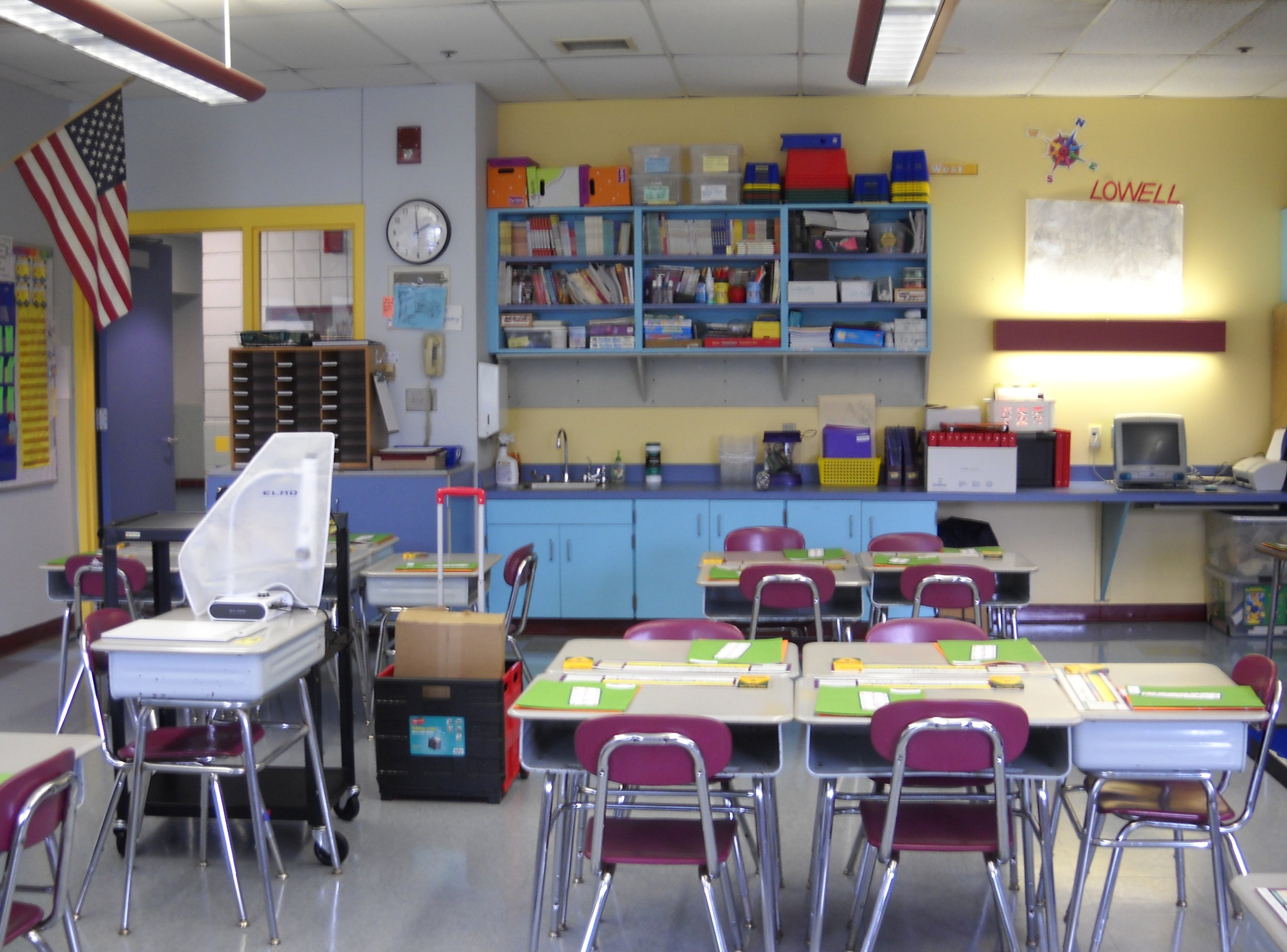
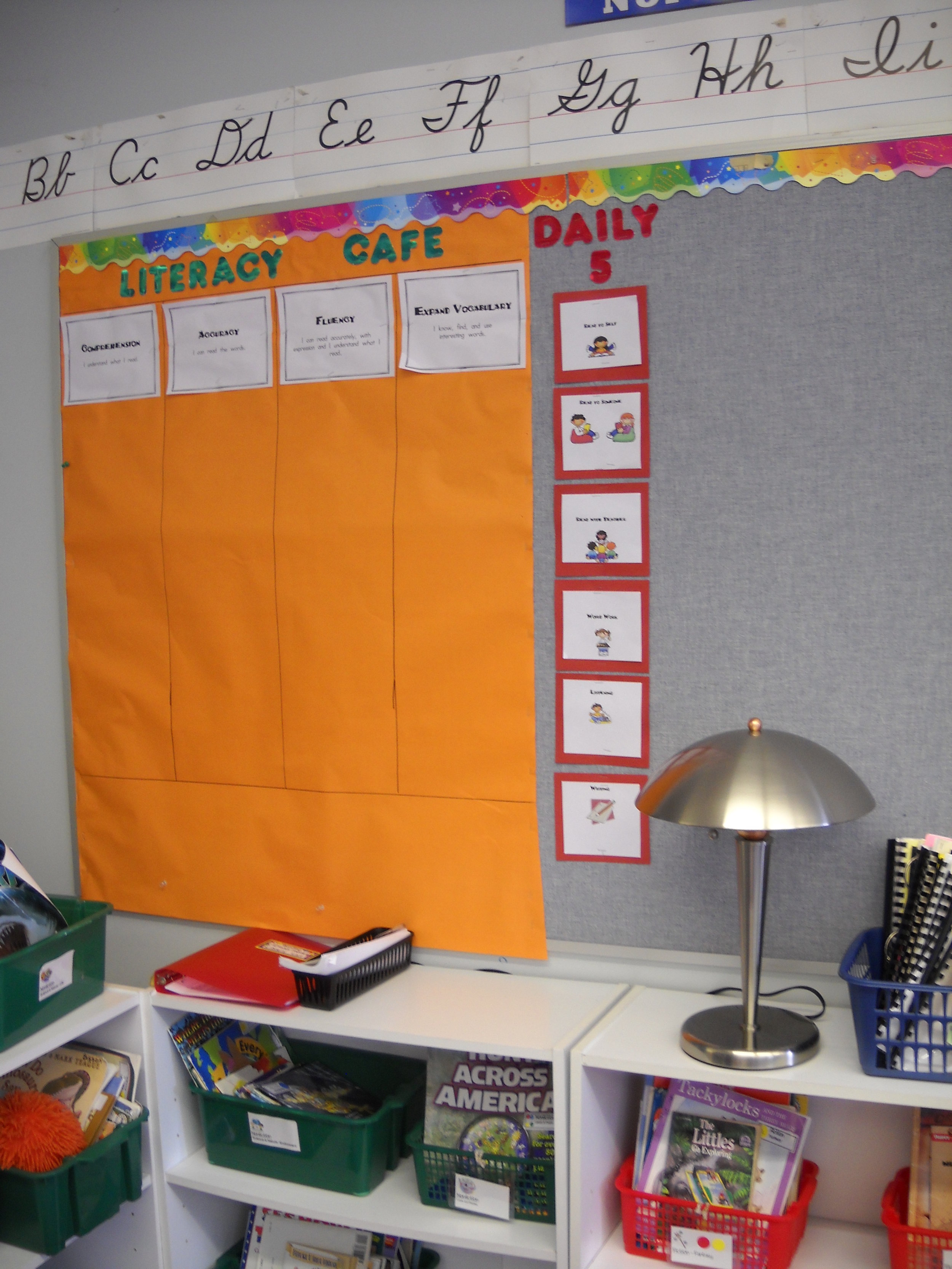
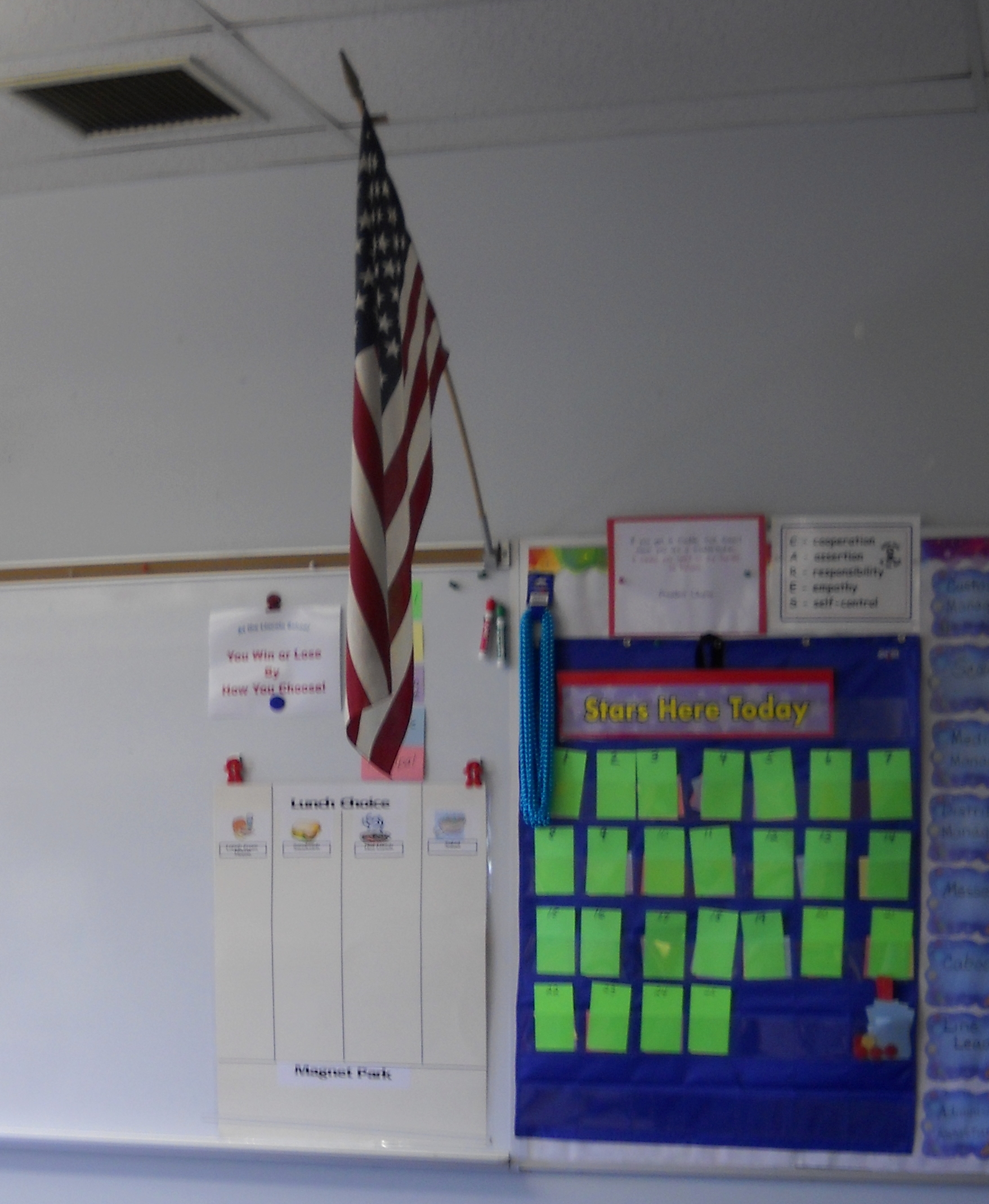

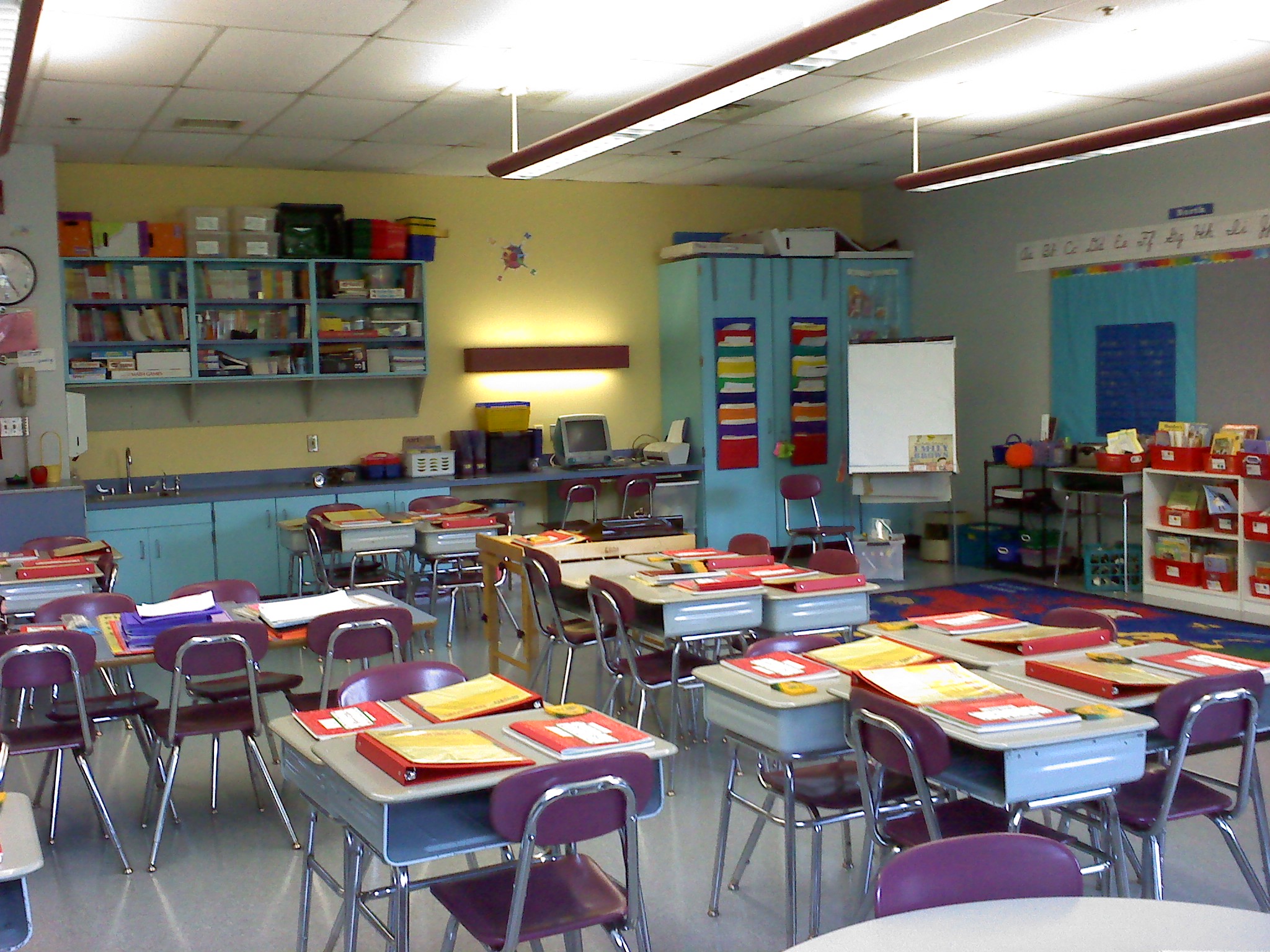 I did change the desk arrangements around, partly to accomodate a student in a wheelchair and with a wheelchair accessible desk and partly because I just don't want to give up on cooperative groupings of 3 or 4 students. I like grouping my students heterogeneously so that they can talk to each other when they are stuck, need help, don't remember what to do. As you can see from this shot, a large meeting area takes a good part of the classroom. It's important to me to get down on the floor on the same level with the students and this is one way I achieve that.At this time, there are minimal supplies on the students' desks. The empty red writing binder and 5 tab dividers, a word study
I did change the desk arrangements around, partly to accomodate a student in a wheelchair and with a wheelchair accessible desk and partly because I just don't want to give up on cooperative groupings of 3 or 4 students. I like grouping my students heterogeneously so that they can talk to each other when they are stuck, need help, don't remember what to do. As you can see from this shot, a large meeting area takes a good part of the classroom. It's important to me to get down on the floor on the same level with the students and this is one way I achieve that.At this time, there are minimal supplies on the students' desks. The empty red writing binder and 5 tab dividers, a word study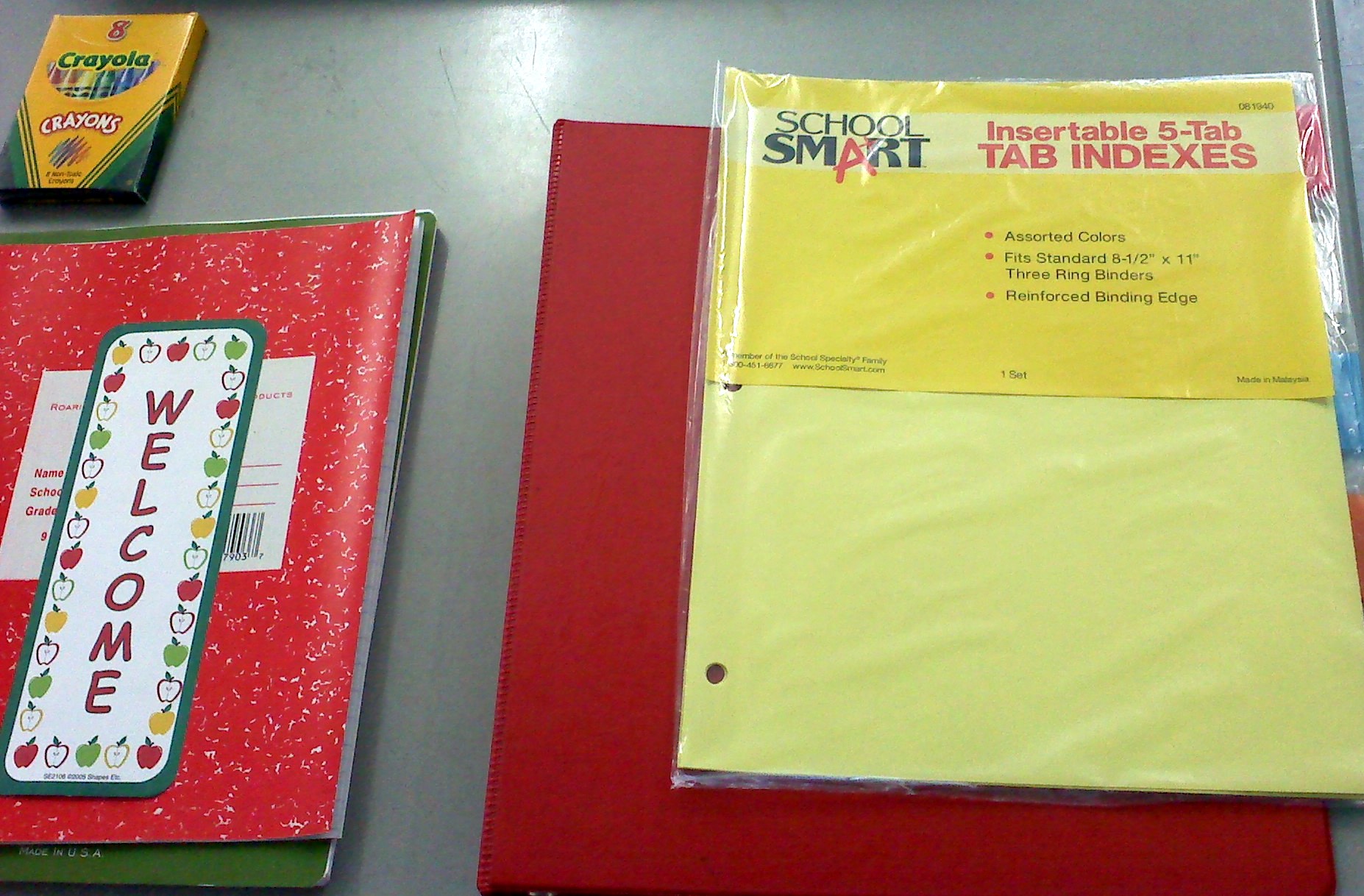 test book, a spiral notebook used as a math journal, crayons and a bookmark. Once my class list is fairly final -- on Monday during Staff Orientation -- I'll add a personalized materials. Working in urban schools for the last 20+ years has taught me to be cautious about personalizing materials until the students actually arrive in the classroom. Over the last week my class roster has fluctuated from 18 to 20 to 19 as students move around the district to another elementary school. Students will continue to enroll in the District through the week after Labor Day as not all parents will be familiar with the early start date.Melissa and I read through the cumlative folders and IEPs of the incoming students. It is good to think and plan ahead for these students: How can we adapt and change materials so that everyone feels successful? There are so many questions that need answers.As of today, the physical space is prepared. The first 3 days of plans have been sketched out, and I am as ready as I can be at the moment. Waiting for the first bell on Tuesday with lots of First Day Jitters.
test book, a spiral notebook used as a math journal, crayons and a bookmark. Once my class list is fairly final -- on Monday during Staff Orientation -- I'll add a personalized materials. Working in urban schools for the last 20+ years has taught me to be cautious about personalizing materials until the students actually arrive in the classroom. Over the last week my class roster has fluctuated from 18 to 20 to 19 as students move around the district to another elementary school. Students will continue to enroll in the District through the week after Labor Day as not all parents will be familiar with the early start date.Melissa and I read through the cumlative folders and IEPs of the incoming students. It is good to think and plan ahead for these students: How can we adapt and change materials so that everyone feels successful? There are so many questions that need answers.As of today, the physical space is prepared. The first 3 days of plans have been sketched out, and I am as ready as I can be at the moment. Waiting for the first bell on Tuesday with lots of First Day Jitters. Time Spent: 4 hoursThis morning I loaded up the Jetta with our new shop vac -- more power! -- and began cleaning up the dust from the floor replacement. Here's what was all over every surface, nook, and cranny of my classroom (even behind closed cupboards - this stuff goes everywhere).Cleanup meant first sucking all the dust with the shop vac and then wet mopping it with paper towels and cleaner -- sometimes twice. It was nasty stuff. The floor installers left some panels off and the floor vents took a major beating as well as one of the built in metal shelves. That'll all need fixing by the pros.By the end of the four hours, The room was cleaned up and all the decorating that I plan to do completed. We are a Responsive Classroom school and one of the things we do to build community is to decorate (reference charts, etc.) together. The only exception I made for myself this year is the alphabet chart. Due to a shoulder injury, I didn't take that down -- but if the students have some preferred spot, I will and with help put it up according to the consensus. So here are a couple of shots of the classroom configuration right now:Meeting Area Rug: The classroom library and a large bulletin board abut this area. I have put the easel at one corner (my coat clo
Time Spent: 4 hoursThis morning I loaded up the Jetta with our new shop vac -- more power! -- and began cleaning up the dust from the floor replacement. Here's what was all over every surface, nook, and cranny of my classroom (even behind closed cupboards - this stuff goes everywhere).Cleanup meant first sucking all the dust with the shop vac and then wet mopping it with paper towels and cleaner -- sometimes twice. It was nasty stuff. The floor installers left some panels off and the floor vents took a major beating as well as one of the built in metal shelves. That'll all need fixing by the pros.By the end of the four hours, The room was cleaned up and all the decorating that I plan to do completed. We are a Responsive Classroom school and one of the things we do to build community is to decorate (reference charts, etc.) together. The only exception I made for myself this year is the alphabet chart. Due to a shoulder injury, I didn't take that down -- but if the students have some preferred spot, I will and with help put it up according to the consensus. So here are a couple of shots of the classroom configuration right now:Meeting Area Rug: The classroom library and a large bulletin board abut this area. I have put the easel at one corner (my coat clo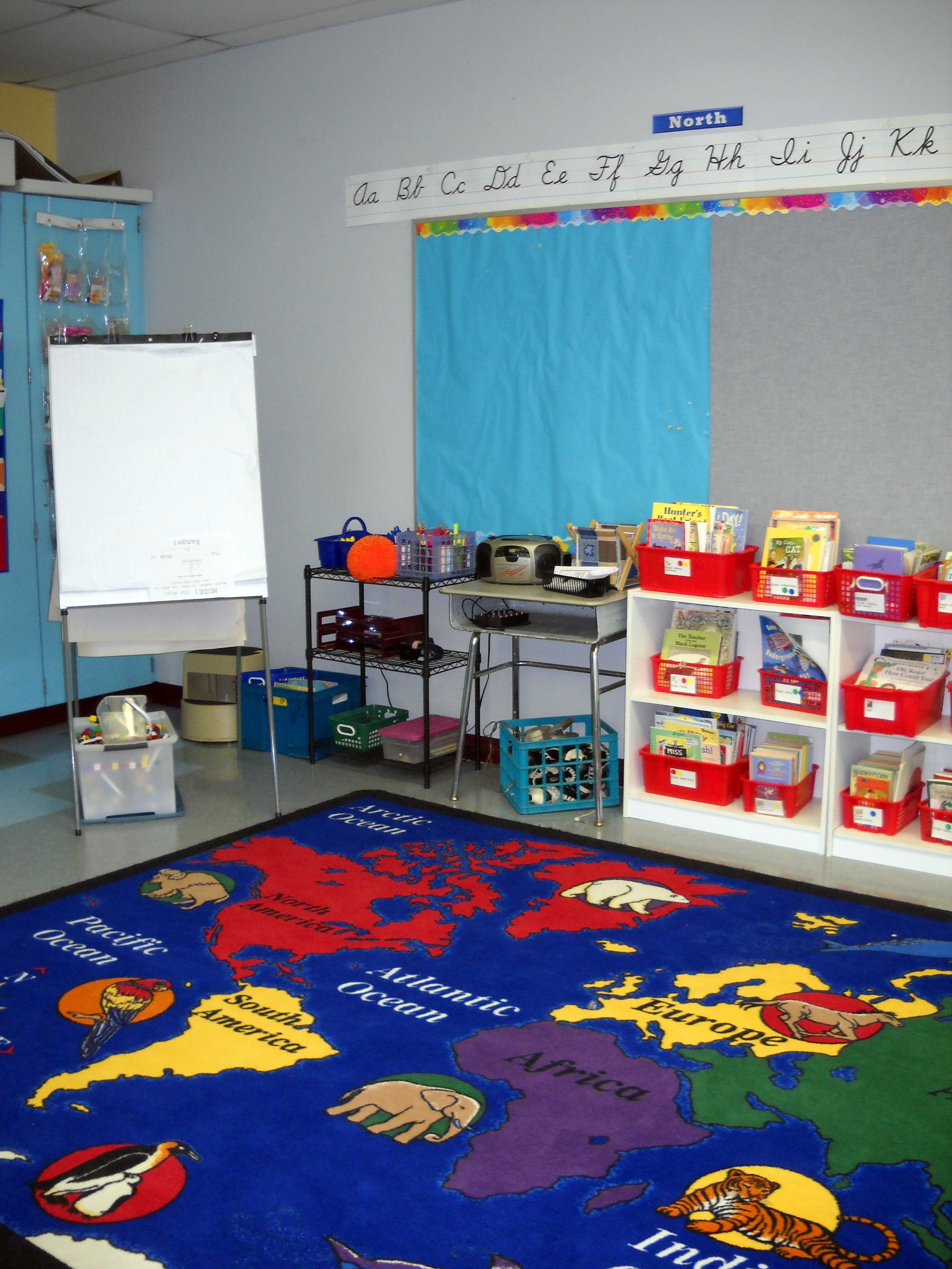 set and 2 storage closets are beyond that) and I keep the snapcubes for our math investigations in a crate under the easel. Also against the wall I have shelves that hold supplies for Writing Workshop (editing/revising pencils, forms, paper, art supplies), a listening center CD player, and a crate of cushions and 2 large beanbags.
set and 2 storage closets are beyond that) and I keep the snapcubes for our math investigations in a crate under the easel. Also against the wall I have shelves that hold supplies for Writing Workshop (editing/revising pencils, forms, paper, art supplies), a listening center CD player, and a crate of cushions and 2 large beanbags.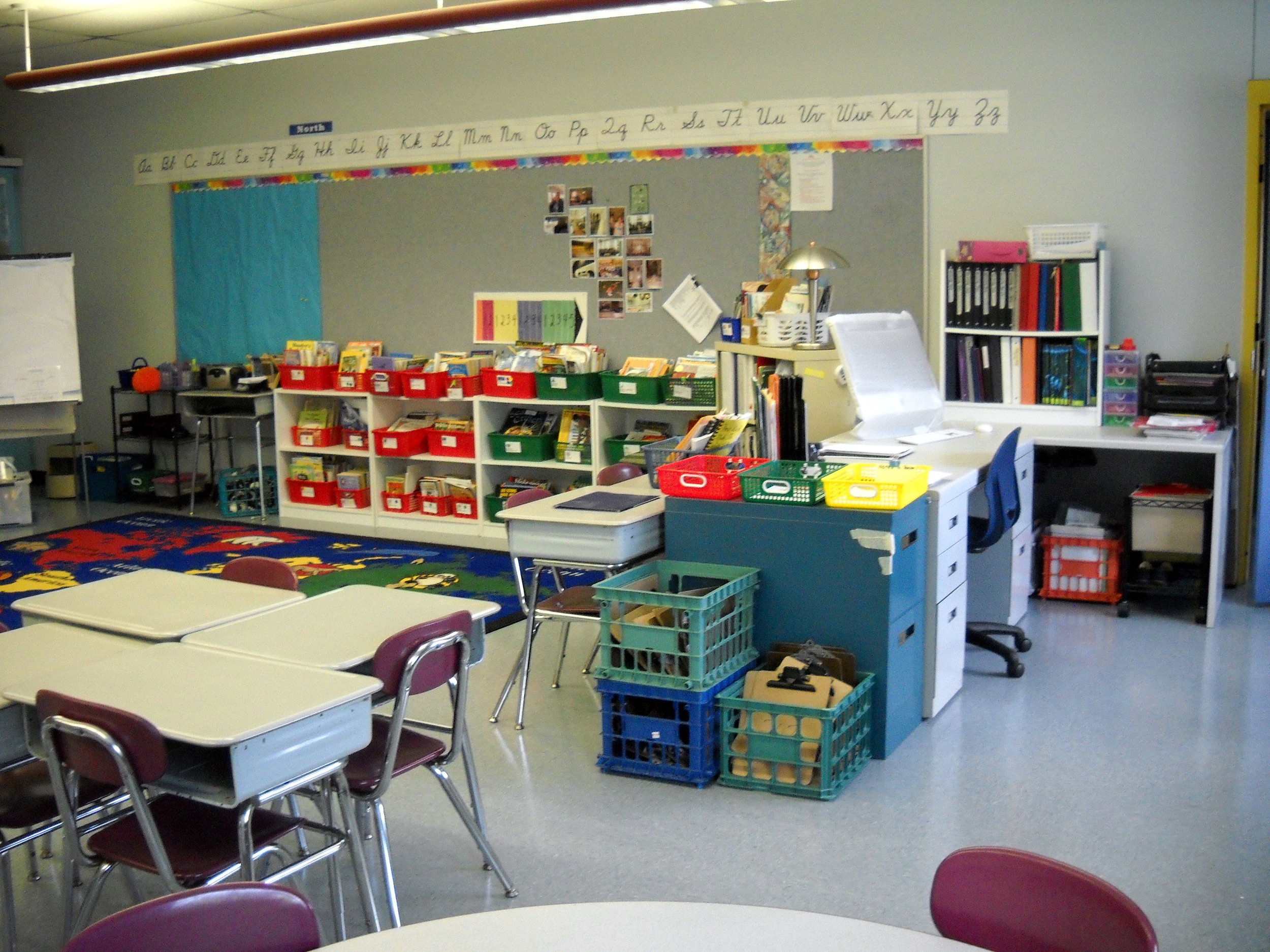 Here's a second view from the front of the room. My desk area, 2 clipboard crates, and my collections baskets are to the right. The table barely visible in the foreground is a round table which I use for conducting small group reading or reading/writing conferences.My current thinking (I love that phrase!) is that I will have students keep all reading materials -- independent
Here's a second view from the front of the room. My desk area, 2 clipboard crates, and my collections baskets are to the right. The table barely visible in the foreground is a round table which I use for conducting small group reading or reading/writing conferences.My current thinking (I love that phrase!) is that I will have students keep all reading materials -- independent book selections, reading binders and any small group materials in the recycled cardboard magazine files (why are the recycled? See the Leveled Library Organization Project) you see on the window shelf. I also will have students keep a reading supply bag in that box - highlighter, stickynotes (cutting a 1/2 pad of 3x2 notes should be enough), bookmark, pencil) - things that take time to locate when moving around the room for Reading Workshop. We create our own Reading Binders using floppy vinyl (red) binders and dividers (more on that later); I'm proud that my students have been very conscientious about taking care of the binders and with one or two exceptions, these are the very same binders I purchased new three years ago. Because there's a very important air flow vent built into the counter directly behind those boxes, I will lay masking tape to mark where the front of the box needs to line up. The blue space behind those boxes is where we generally put a word/vocabulary wall.
book selections, reading binders and any small group materials in the recycled cardboard magazine files (why are the recycled? See the Leveled Library Organization Project) you see on the window shelf. I also will have students keep a reading supply bag in that box - highlighter, stickynotes (cutting a 1/2 pad of 3x2 notes should be enough), bookmark, pencil) - things that take time to locate when moving around the room for Reading Workshop. We create our own Reading Binders using floppy vinyl (red) binders and dividers (more on that later); I'm proud that my students have been very conscientious about taking care of the binders and with one or two exceptions, these are the very same binders I purchased new three years ago. Because there's a very important air flow vent built into the counter directly behind those boxes, I will lay masking tape to mark where the front of the box needs to line up. The blue space behind those boxes is where we generally put a word/vocabulary wall.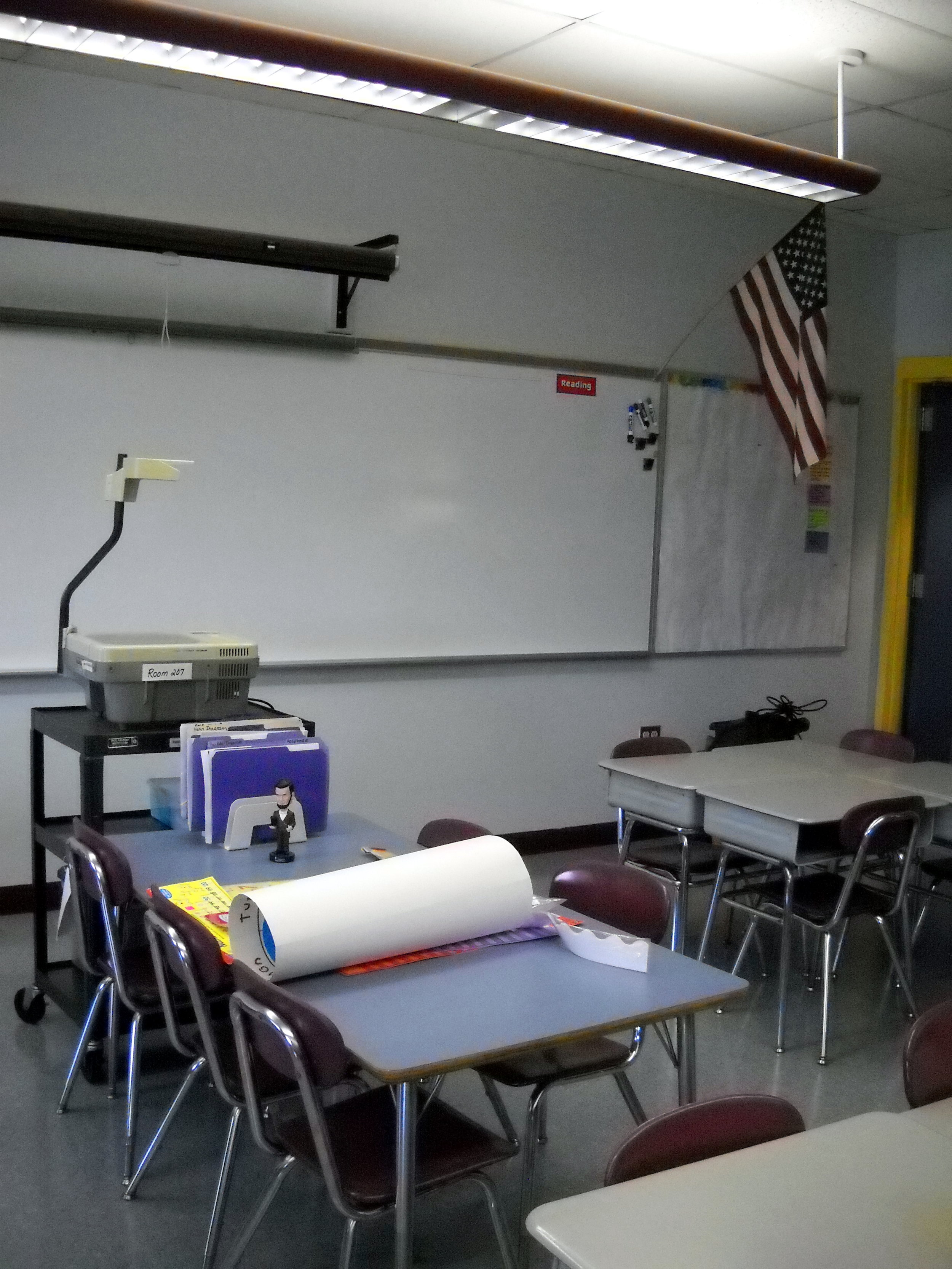 The front of the room looks the most bare at the moment. Usually on one end of the white board we record homework assignments and on the other we keep a magnetic chart tracking where students are in the writing process. I also hang a daily poster of our Reading Workshop Schedule at the front of the room. I do use an overhead a lot. Storing it at the end of the second reading/conference table and rolling it into position works for me. I have a rack of frequently used materials (Venn diagrams, blank story maps) on this table so that students can take them independently.When I moved from the Bailey School to the Lincoln School I was excited because of the shelves! The Lincoln was
The front of the room looks the most bare at the moment. Usually on one end of the white board we record homework assignments and on the other we keep a magnetic chart tracking where students are in the writing process. I also hang a daily poster of our Reading Workshop Schedule at the front of the room. I do use an overhead a lot. Storing it at the end of the second reading/conference table and rolling it into position works for me. I have a rack of frequently used materials (Venn diagrams, blank story maps) on this table so that students can take them independently.When I moved from the Bailey School to the Lincoln School I was excited because of the shelves! The Lincoln was 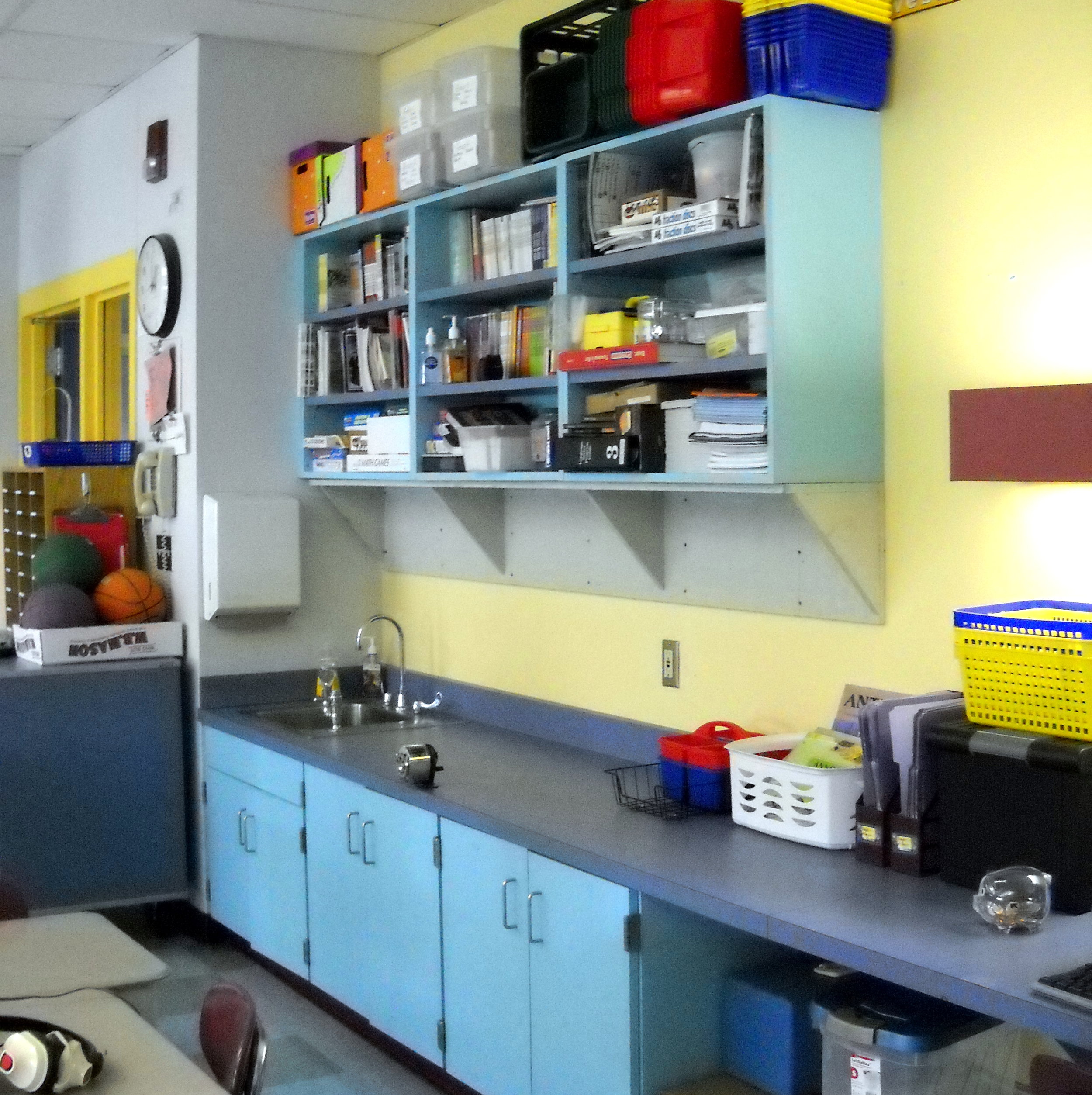 constructed one year after the Bailey and the architect apparently didn't think shelf units over the sink area would be all that useful. Luckily, when the Lincoln was constructed a revision was made and the shelves are well used! In fact, I wish there were more of them -- but then that would just encourage teachers like me to hold on to more STUFF. I have a rolling "art cart" in which I keep a minimal amount of construction paper and lots of composition and math paper. On top of that cart, I have a 24-section sorting file that is used as student mailboxes.
constructed one year after the Bailey and the architect apparently didn't think shelf units over the sink area would be all that useful. Luckily, when the Lincoln was constructed a revision was made and the shelves are well used! In fact, I wish there were more of them -- but then that would just encourage teachers like me to hold on to more STUFF. I have a rolling "art cart" in which I keep a minimal amount of construction paper and lots of composition and math paper. On top of that cart, I have a 24-section sorting file that is used as student mailboxes. This final shot is a closeup of the coat/storage closet area. Over the first 2 doors are pocket folders from R
This final shot is a closeup of the coat/storage closet area. Over the first 2 doors are pocket folders from R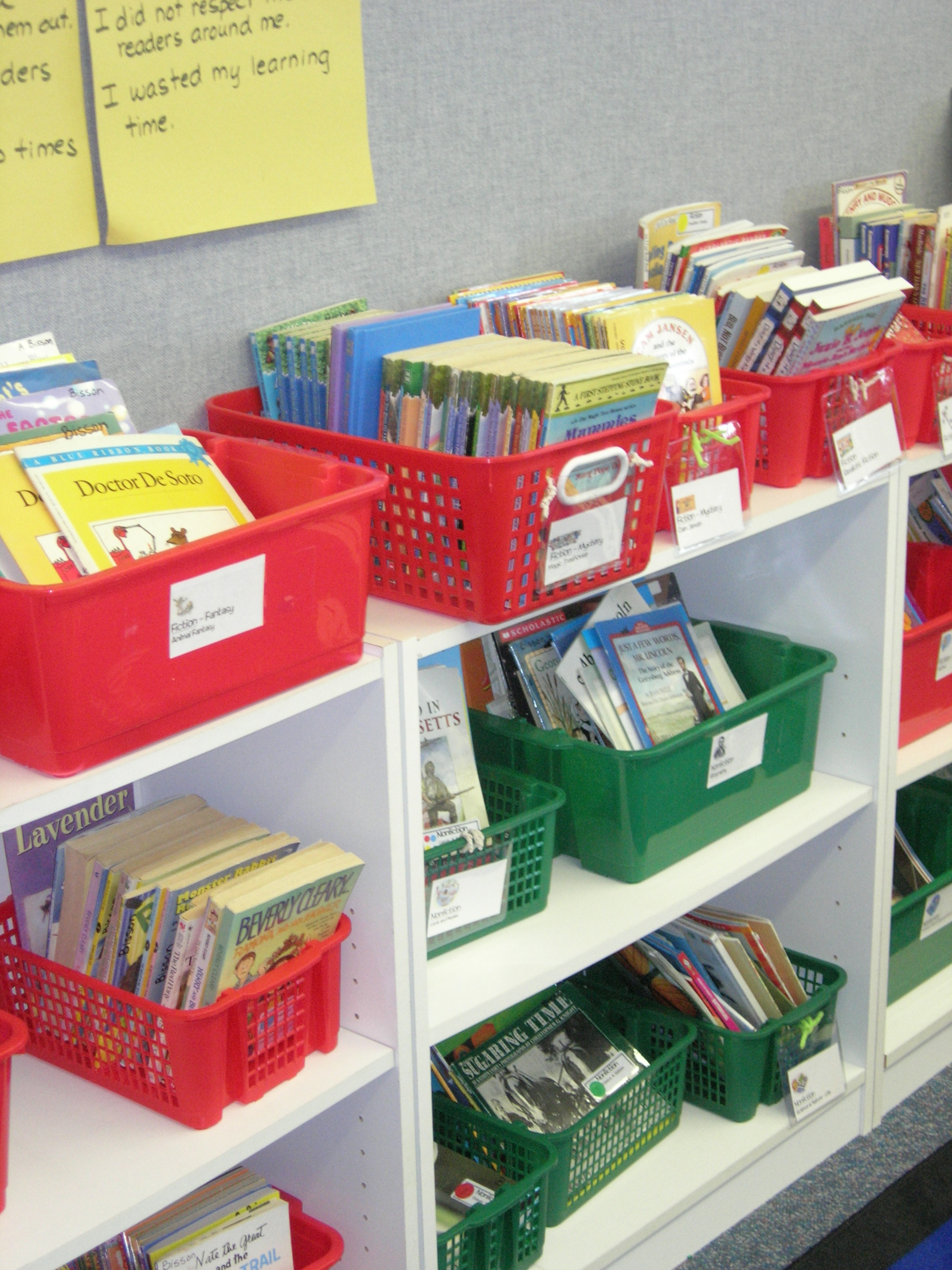 The book baskets have been labeled and, when needed there are level reminders on the baskets.On Monday, we talked as a class about the labels and what that meant as far as replacing books or looking for new texts to enjoy. The students listened and asked questions and took their role as initiators of the new library very seriously. During each guided reading group this week, students have been returning all the books that had previously come from the library. Many of these books were either unlabeled -- and therefore not in the database as of yet -- or an inappropriate level for the student.Another part of the process is to get kids picking books at their independent level. First, I created a large wall poster listing all of the levels (color coded). Then, using the last Fountas Pinnell benchmark as a guide, each child got a new book selection bookmark with a colored dot indicating the level of books that should be "just right". Students were instructed to pick 3 books from the library using the colored dot as a guide. They can pick one level up or one level down from the dot. I dislike putting a number limit on the books being checked out of the library and some time I hope to remove this from the groundrules. However, for whatever reason, I have quite a few students who hoard books -- 10 or more at a time -- and I'd like the books to be in circulation for everyone.Using the guidelines for selecting books from the library proved to be a challenge for the students and an eye-opener for me . I thought the obvious benefit was going to be in the newly organized library. Little did I realize how much my students needed structure in selecting just-right books! My students, many of whom are under confident about their reading, gravitated to books that were well below what they should be reading in order to grow as a reader. For example, students who should be reading N chapter books (Yellow 4), were begging to reading Yellow 1 or Yellow 2 picture books. Left to their own, they were selecting materials that would not challenge them to become better readers. The new guidelines definitely appears to be a benefit of the new leveled library -- one that I hadn't even anticipated. We are now having conversations about why reading at your level is a good goal and when reading a very easy book might be okay.So as this project is winding down I can see there have been some real benefit from the work involved. In addition to organizing the materials, and knowing first-hand what is available in the library, knowing how many of each genre and level will help me to make sensible choices when I purchase new books for the classroom. The library has been consolidated so that the organization is more transparent and kid-friendly -- holy cow, they even are putting the books away in the right bins! And it is becoming less easy to slide by picking books that are too far below the students' reading levels to challenge them.Happy new library, Room 207! Now let's get reading.
The book baskets have been labeled and, when needed there are level reminders on the baskets.On Monday, we talked as a class about the labels and what that meant as far as replacing books or looking for new texts to enjoy. The students listened and asked questions and took their role as initiators of the new library very seriously. During each guided reading group this week, students have been returning all the books that had previously come from the library. Many of these books were either unlabeled -- and therefore not in the database as of yet -- or an inappropriate level for the student.Another part of the process is to get kids picking books at their independent level. First, I created a large wall poster listing all of the levels (color coded). Then, using the last Fountas Pinnell benchmark as a guide, each child got a new book selection bookmark with a colored dot indicating the level of books that should be "just right". Students were instructed to pick 3 books from the library using the colored dot as a guide. They can pick one level up or one level down from the dot. I dislike putting a number limit on the books being checked out of the library and some time I hope to remove this from the groundrules. However, for whatever reason, I have quite a few students who hoard books -- 10 or more at a time -- and I'd like the books to be in circulation for everyone.Using the guidelines for selecting books from the library proved to be a challenge for the students and an eye-opener for me . I thought the obvious benefit was going to be in the newly organized library. Little did I realize how much my students needed structure in selecting just-right books! My students, many of whom are under confident about their reading, gravitated to books that were well below what they should be reading in order to grow as a reader. For example, students who should be reading N chapter books (Yellow 4), were begging to reading Yellow 1 or Yellow 2 picture books. Left to their own, they were selecting materials that would not challenge them to become better readers. The new guidelines definitely appears to be a benefit of the new leveled library -- one that I hadn't even anticipated. We are now having conversations about why reading at your level is a good goal and when reading a very easy book might be okay.So as this project is winding down I can see there have been some real benefit from the work involved. In addition to organizing the materials, and knowing first-hand what is available in the library, knowing how many of each genre and level will help me to make sensible choices when I purchase new books for the classroom. The library has been consolidated so that the organization is more transparent and kid-friendly -- holy cow, they even are putting the books away in the right bins! And it is becoming less easy to slide by picking books that are too far below the students' reading levels to challenge them.Happy new library, Room 207! Now let's get reading.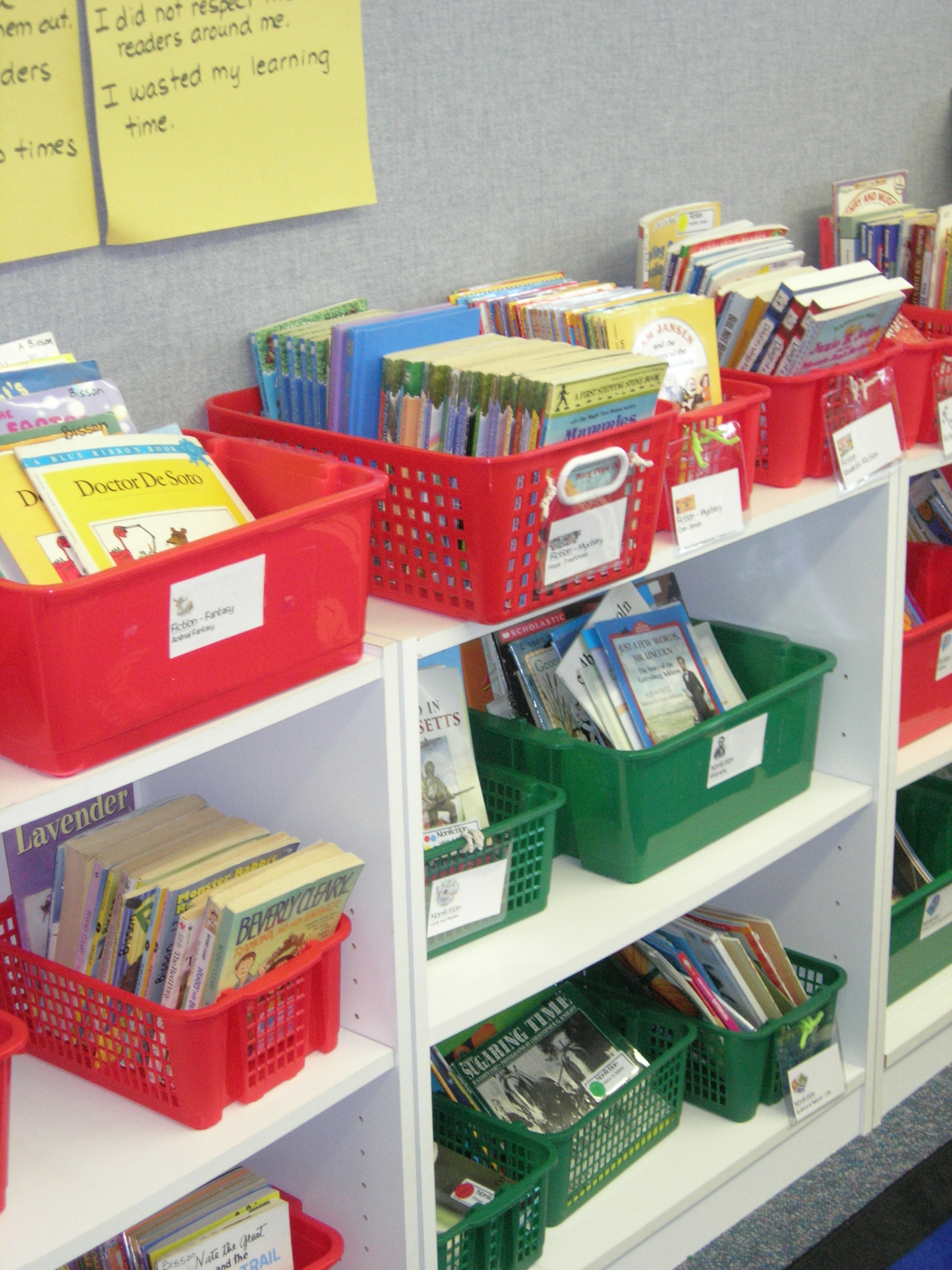 his week I spent most of a "day off" in school sorting through the books that had been labeled and logged and organizing them into color coded baskets - red for fiction, green for nonfiction, blue for poetry and yellow for special collections. Using both the small nesting baskets from Really Good Stuff and the stackable medium bins has been a good thing. And the shelves are beginning to look like something other than the mishmash that had been. At this point, I have finished the most tedious leveling - those 500+ books that had not been leveled at all - and I am sorting through the baskets in of previously leveld books. Will need to weed out used and otherwise unattractive books.I hate the feel of books that have been sitting on the shelf - in the warm sun and near the blowers for the heating system in the classroom. They feel dusty, the paper pages feel rough and uncomfortable and often the covers are worn or brittle. These are the books that I've been recycling rather aggressively. Those that belong to the school and were purchased with school funds (Title I, building budget, etc.) are shared with colleagues who need to bulk up their own classroom library or with the Lincoln Lenders. The later is a collection of books for our students to swap - something that happens about once each month. Bring a book to trade and get one in return. It works quite well and more and more children are able to have a book of their own.A side-activity to the classroom library sorting is that I have been classifying my own teacher collection of trade
his week I spent most of a "day off" in school sorting through the books that had been labeled and logged and organizing them into color coded baskets - red for fiction, green for nonfiction, blue for poetry and yellow for special collections. Using both the small nesting baskets from Really Good Stuff and the stackable medium bins has been a good thing. And the shelves are beginning to look like something other than the mishmash that had been. At this point, I have finished the most tedious leveling - those 500+ books that had not been leveled at all - and I am sorting through the baskets in of previously leveld books. Will need to weed out used and otherwise unattractive books.I hate the feel of books that have been sitting on the shelf - in the warm sun and near the blowers for the heating system in the classroom. They feel dusty, the paper pages feel rough and uncomfortable and often the covers are worn or brittle. These are the books that I've been recycling rather aggressively. Those that belong to the school and were purchased with school funds (Title I, building budget, etc.) are shared with colleagues who need to bulk up their own classroom library or with the Lincoln Lenders. The later is a collection of books for our students to swap - something that happens about once each month. Bring a book to trade and get one in return. It works quite well and more and more children are able to have a book of their own.A side-activity to the classroom library sorting is that I have been classifying my own teacher collection of trade 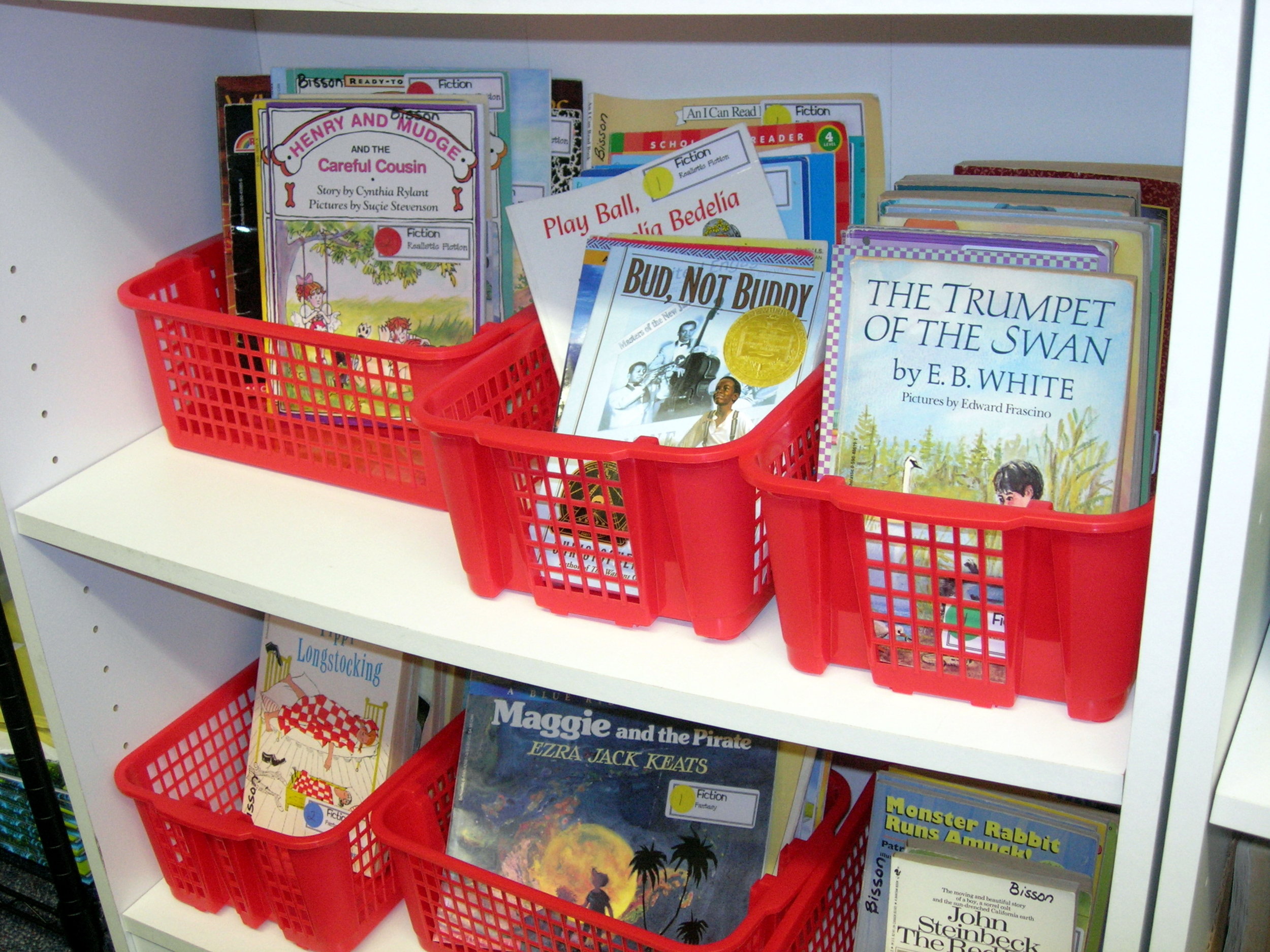 The second glitch this week was in the color coded baskets. There are WAY too many books -- can you believe it -- for the baskets I have. And the small stacking baskets, while just the right size for paperback chapter books, are too small for the picture books unless I turn the basket on the long side. This means I lose some shelf space and will probably mean the goal of getting books off of the counters in not reasonable. I've noticed that
The second glitch this week was in the color coded baskets. There are WAY too many books -- can you believe it -- for the baskets I have. And the small stacking baskets, while just the right size for paperback chapter books, are too small for the picture books unless I turn the basket on the long side. This means I lose some shelf space and will probably mean the goal of getting books off of the counters in not reasonable. I've noticed that 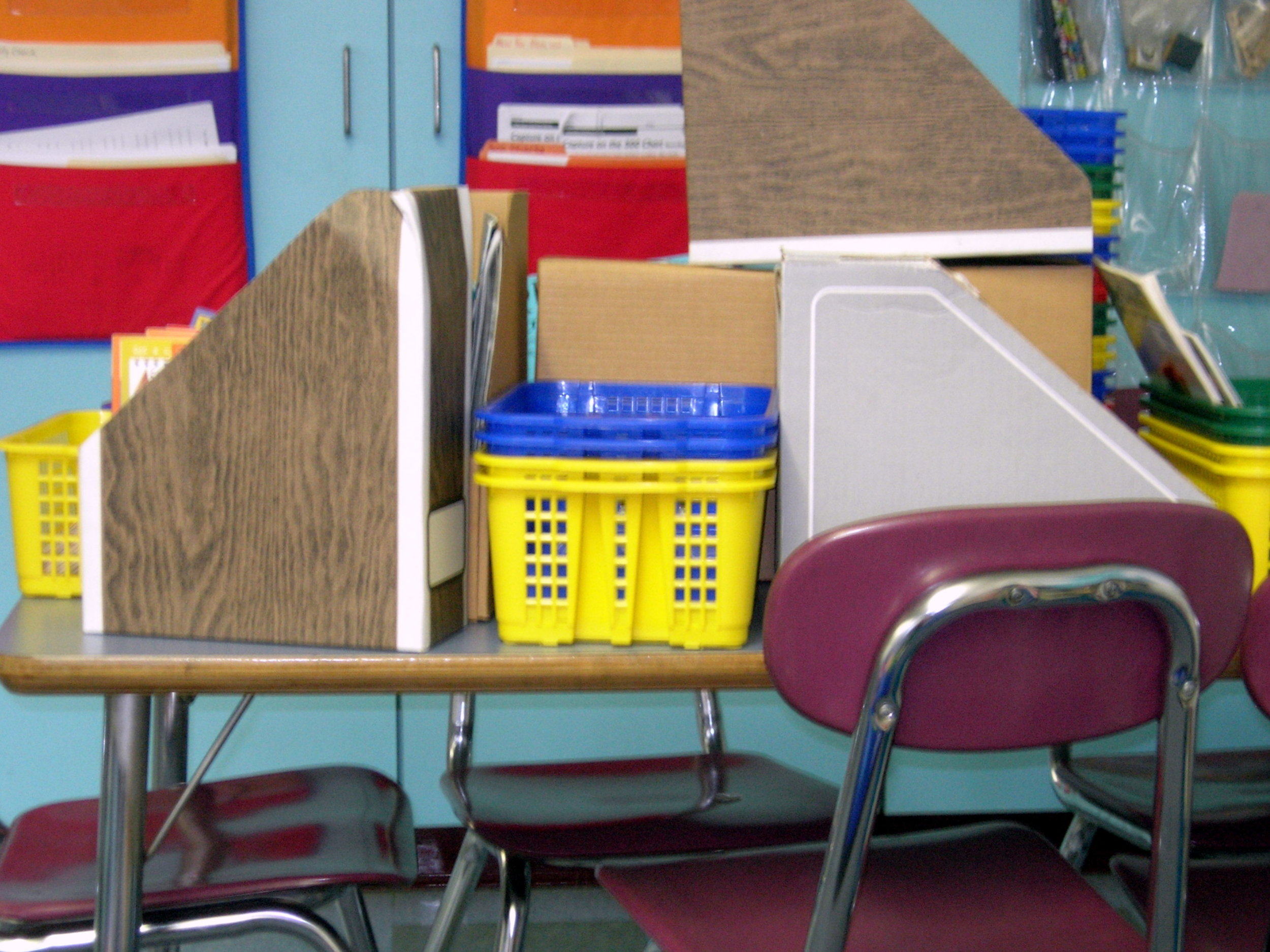 Now, what to do with those cardboard magazine boxes? They're too good to throw away (and if you are or live with a teacher you know throwing things away just isn't something we do). I'll need to come to a decision soon as they are starting to take over the table and desk space!So on the To-Do list for the coming week is to finish labeling the rest of the newly categorized library, solve the basket issue, and, oh yes.... get rid of the clutter before it drives everyone crazy.
Now, what to do with those cardboard magazine boxes? They're too good to throw away (and if you are or live with a teacher you know throwing things away just isn't something we do). I'll need to come to a decision soon as they are starting to take over the table and desk space!So on the To-Do list for the coming week is to finish labeling the rest of the newly categorized library, solve the basket issue, and, oh yes.... get rid of the clutter before it drives everyone crazy.










